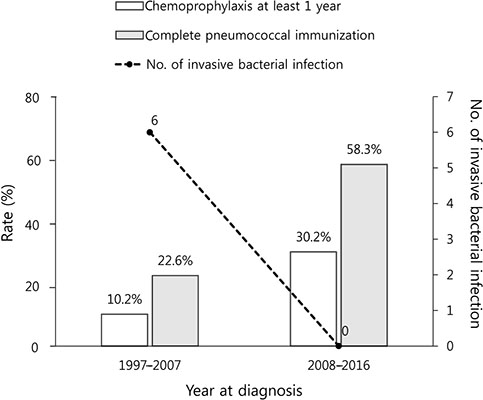Pediatr Infect Vaccine.
2017 Dec;24(3):160-167. 10.14776/piv.2017.24.3.160.
A Retrospective Study of Invasive Bacterial Infections in Children with Asplenia
- Affiliations
-
- 1Department of Pediatrics, Asan Medical Center, University of Ulsan College of Medicine, Seoul, the Republic of Korea. entier@amc.seoul.kr
- KMID: 2401391
- DOI: http://doi.org/10.14776/piv.2017.24.3.160
Abstract
- PURPOSE
Because children with asplenia have an increased risk of fulminant infection associated with a high fatality, chemoprophylaxis, and vaccinations against encapsulated bacteria are recommended. However, there have been few reports of the burden of severe bacterial infection and the current status of chemoprophylaxis and immunization among children with asplenia in Korea.
METHODS
We conducted a retrospective study including children with asplenia who were treated at our institute between January 1997 and December 2016.
RESULTS
From a total of 213 children with asplenia, 114 (53.5%) had congenital asplenia and 58 (27.2%) had functional asplenia. The remaining 41 (19.3%) had acquired asplenia with the median age at splenectomy being 12.2 years (range, 5.0 to 16.9 years); the most common cause of splenectomy was hereditary spherocytosis (39.0%). The chemoprophylaxis rate was 16.4%. The immunization rates were 44.1% for pneumococcus, 53.0% for Haemophilus influenzae type B, and 10.7% for meningococcus. The incidence of invasive bacterial infection among children with asplenia was 0.28/100 person-year; a total of six episodes (2.8%) were observed in five patients with congenital asplenia and one patient with functional asplenia. The median age for these infections was 15 months (range, 4 to 68 months). Five of the six episodes were bacteremia, and the other was meningitis. The most common pathogen was Streptococcus pneumoniae (n=3), followed by H.influenzae (n=1). Three of the six patients (50.0%) died, all of whom had pneumococcal bacteremia. None of the six had chemoprophylaxis or proper vaccinations.
CONCLUSIONS
Although there is an increased risk of a severe infection proper vaccinations and chemoprophylaxis are still lacking. Physicians should be encouraged to implement appropriate chemoprophylaxis and immunizations for patients with asplenia.
Keyword
MeSH Terms
Figure
Reference
-
1. American Academy of Pediatrics Committee on Infectious Diseases. Pickering LK, Baker CJ, Kimberlin DW, Long SS. Red book: 2012 report of the Committee on Infectious Diseases. 29th ed. Elk Grove Village: American Academy of Pediatrics;2012. p. 88–90.2. Gilsdorf JR. Infections in Asplenic Patients. In : Bennett JE, Dolin R, Blaser MJ, editors. Mandell, douglas, and bennett's principles and practice of infectious diseases. 8th ed. Philadelphia: Elsevier Health Sciences;2015. p. 3466–3474.3. Davies JM, Lewis MP, Wimperis J, Rafi I, Ladhani S, Bolton-Maggs PH, et al. Review of guidelines for the prevention and treatment of infection in patients with an absent or dysfunctional spleen: prepared on behalf of the British Committee for Standards in Haematology by a working party of the Haemato-Oncology task force. Br J Haematol. 2011; 155:308–317.
Article4. El-Alfy MS, El-Sayed MH. Overwhelming postsplenectomy infection: is quality of patient knowledge enough for prevention. Hematol J. 2004; 5:77–80.
Article5. Choi JY, Yun YS, Hong CY. Clinical study on asplenia and polysplenia syndrome. J Korean Pediatr Soc. 1989; 32:653–658.6. The Korean Pediatric Society. 2015 Report of the committee on infectious disease. Immunization guideline. 8th ed. Seoul: The Korean Pediatric Society;2015.7. Center for Disease Control and Prevention/National Healthcare Safety Network. Bloodstream infection event (central line-associated bloodstream infection and noncentral line-associated bloodstream infection) [Internet]. Atlanta: Center for Disease Control and Prevention;2016. cited 2017 Oct 9. Available from: http://www.cdc.gov.8. Rubin LG, Schaffner W. Clinical practice. Care of the asplenic patient. N Engl J Med. 2014; 371:349–356.9. Styrt B. Infection associated with asplenia: risks, mechanisms, and prevention. Am J Med. 1990; 88:33N–42N.10. Lynch AM, Kapila R. Overwhelming postsplenectomy infection. Infect Dis Clin North Am. 1996; 10:693–707.
Article11. Bisharat N, Omari H, Lavi I, Raz R. Risk of infection and death among post-splenectomy patients. J Infect. 2001; 43:182–186.
Article12. Kyaw MH, Holmes EM, Toolis F, Wayne B, Chalmers J, Jones IG, et al. Evaluation of severe infection and survival after splenectomy. Am J Med. 2006; 119:276.
Article13. Thomsen RW, Schoonen WM, Farkas DK, Riis A, Jacobsen J, Fryzek JP, et al. Risk for hospital contact with infection in patients with splenectomy: a population-based cohort study. Ann Intern Med. 2009; 151:546–555.
Article14. Waghorn DJ, Mayon-White RT. A study of 42 episodes of overwhelming post-splenectomy infection: is current guidance for asplenic individuals being followed. J Infect. 1997; 35:289–294.
Article15. Theilacker C, Ludewig K, Serr A, Schimpf J, Held J, Bogelein M, et al. Overwhelming postsplenectomy infection: a prospective multicenter cohort study. Clin Infect Dis. 2016; 62:871–878.
Article16. Mahlaoui N, Minard-Colin V, Picard C, Bolze A, Ku CL, Tournilhac O, et al. Isolated congenital asplenia: a French nationwide retrospective survey of 20 cases. J Pediatr. 2011; 158:142–148.
Article17. Jacobsen CT, Shurin SB. Disorders of the spleen. In : Stossel TP, Handin RI, Lux SE, editors. Blood: principles and practice of hematology. 2nd ed. Philadelphia: Lippincott Williams & Wilkins;2003. p. 649–672.18. Lee S. Investigation and management of children with no vaccinations recorded on the National Immunization Registry Information System. . Cheongju: Korea Centers for Disease Control & Prevention;2016.
- Full Text Links
- Actions
-
Cited
- CITED
-
- Close
- Share
- Similar articles
-
- Clinical Entities and Etiology of Invasive Bacterial Infections in Apparently Healthy Children
- Etiology of Invasive Bacterial Infections in Apparently Healthy Children
- A Retrospective Analysis of Characteristics of Probiotics Associated with Invasive Bacterial Infections in Children
- Clinical Manifestations of Invasive Infections due to Streptococcus pyogenes in Children
- Population-Based Epidemiologic Studies of Invasive Bacterial Infections in Korea


